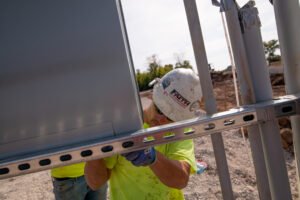09.27.2022
Understanding Ergonomic Hazards in the Workplace
 According to the Occupational Safety and Health Administration (OSHA), work-related musculoskeletal disorders (MSDs) or ergonomic injuries are the most frequently reported causes of lost or restricted work time. These types of injuries can be acute or chronic and can affect a person’s muscles, nerves, blood vessels, ligaments and tendons. All employees in the workplace have the potential to experience an ergonomic-related injury. Some of the common situations employees encounter in the construction industry are using excessive force (pushing/pulling), working in awkward positions and heavy lifting.
According to the Occupational Safety and Health Administration (OSHA), work-related musculoskeletal disorders (MSDs) or ergonomic injuries are the most frequently reported causes of lost or restricted work time. These types of injuries can be acute or chronic and can affect a person’s muscles, nerves, blood vessels, ligaments and tendons. All employees in the workplace have the potential to experience an ergonomic-related injury. Some of the common situations employees encounter in the construction industry are using excessive force (pushing/pulling), working in awkward positions and heavy lifting.
Although ergonomic injuries are common, they are easily preventable with proper planning and preparation. Understanding how to identify and prevent ergonomic hazards on the job site will ensure that all employees are able to perform their jobs safely. By simply using the hierarchy of controls to evaluate each situation, we can identify solutions that either eliminate or greatly reduce the risk of experiencing an MSD in the workplace.
- Elimination is the most effective way to ensure that an MSD is not experienced, by completely removing the potential of injury from the worker. An example of this is subcontracting a task to experts in the field who have the proper tools and training to perform specific types of work.
- Substitution is the next step, swapping one tool or process with another safer, more effective solution. An example of this is performing an overhead drilling task with an overhead drill machine rather than using a hand drill working from a ladder or lift.
- Engineering can be used to adjust a workstation or tool to the employee. An example of this is setting up a tool/parts cart at waist height rather than having an employee bend or squat to perform the work on the floor.
- Administrative processes refer to changing the way a task is performed. Some simple solutions for this are rotating tasks for team members. This prevents employees from remaining in static positions while performing similar tasks throughout the day.
- PPE is the final solution for any hazard and should not be used as the only option. An example of ergonomic support PPE is the use of anti-vibration gloves for workers who utilize tools or equipment that vibrate as part of their operation.
At Faith Technologies, we know that understanding the task at hand, planning for work activities and performing stretch and flex activities prior to starting any work will get our minds and bodies ready to complete the task safely. There are many resources and tools available which considerably reduce the ergonomic risks that our team members are exposed to. Working with employees and supervisors to find the best ergonomic solutions helps ensure that all employees can stay injury free each day.
If you enjoyed this blog article, please subscribe to stay up to date on the latest industry news from our experts at Faith Technologies.



